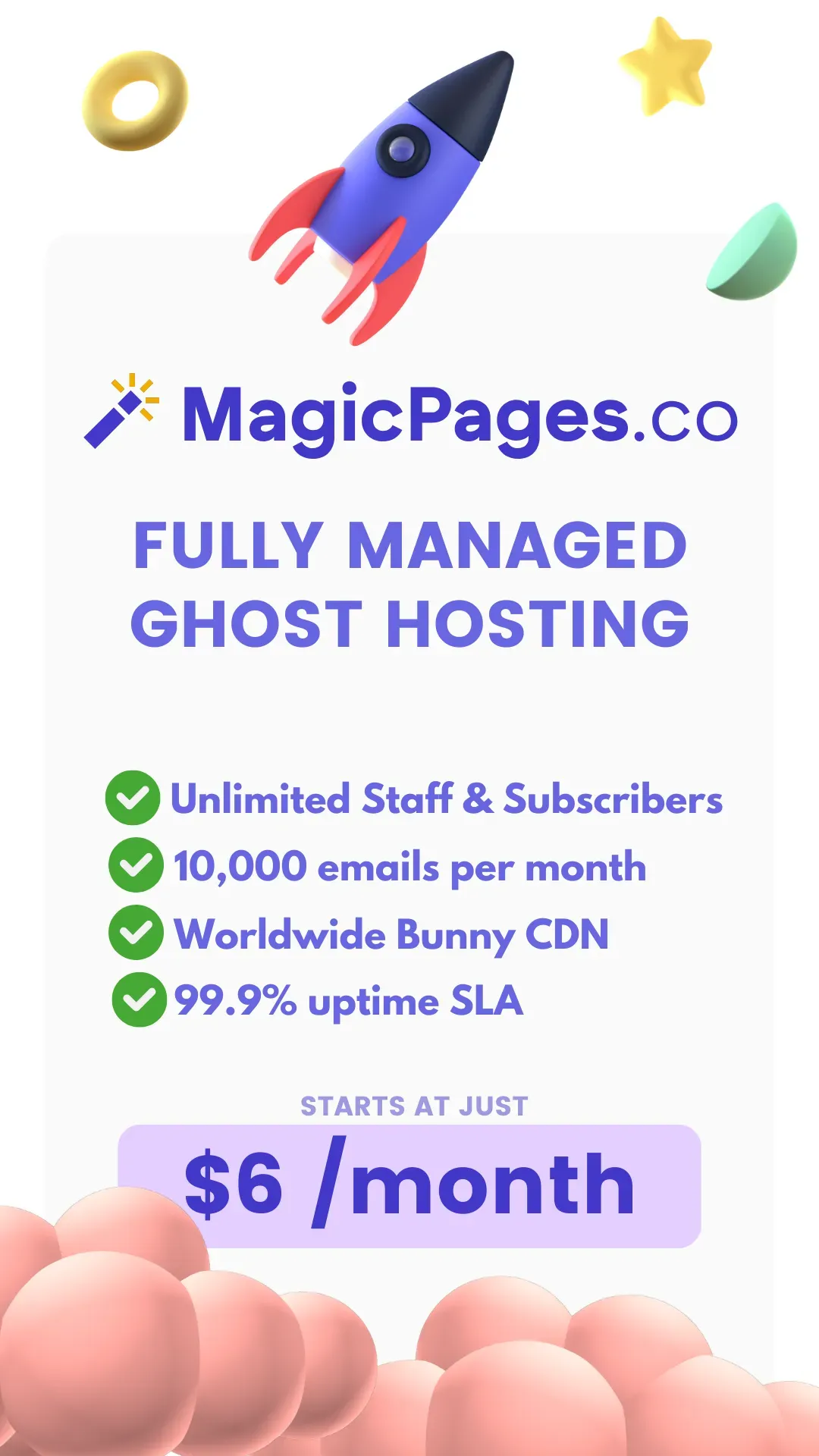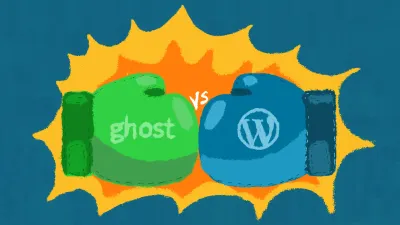Ghost CMS might seem tiny compared to giants like WordPress or Shopify, but there's more to it than meets the eye! While Ghost holds just 0.1% market share, it's laser-focused on independent publishers and creators who value simplicity and total ownership. Technical hurdles, niche targeting, competition from easy-to-use platforms like Substack and Medium, and limited marketing have kept its adoption low. Yet, Ghost keeps thriving—steadily adding innovative features, integrations, and loyal users who love its performance, transparency, and creative freedom. Curious about Ghost's future? Expect steady growth as creators increasingly choose independence and control over quick-and-easy platforms!
Hello and welcome! I’m a long-time content creator who’s always on the lookout for the best publishing platform. Lately, I’ve been fascinated by Ghost CMS – an open-source, modern publishing platform – and a puzzling question: Why does Ghost have such a tiny market share compared to giants like WordPress, despite continuous growth and improvements? In this article, I’ll dive deep into Ghost’s market share, compare Ghost with leading CMS and publishing platforms (WordPress, Shopify, Webflow, Blogger, Substack, Medium, Beehiiv, Patreon, etc.), and explore the reasons behind Ghost’s low adoption. I’ll also highlight how Ghost is evolving and what the future might hold for this unique platform. Let’s get started!
Market Share Analysis: Ghost vs. the Giants
To set the stage, let’s look at the market share numbers. According to the latest web surveys, Ghost CMS is used by only about 0.1% of all websites. Yes, you read that correctly – one-tenth of one percent. Regarding content management systems (CMS) specifically, Ghost holds around 0.1% of the CMS market.
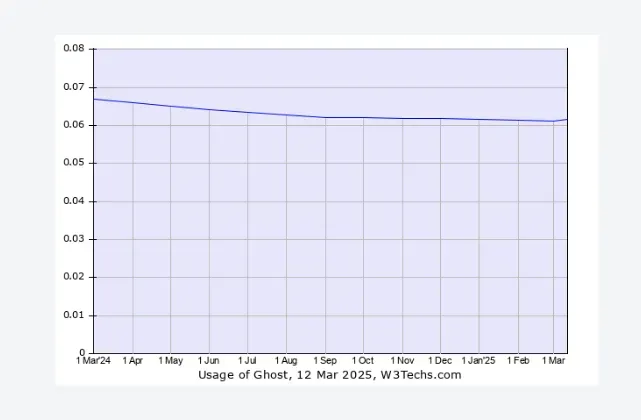
This is a tiny slice, especially when you compare it to the market leaders:
- WordPress – the reigning champion – powers ~43.6% of all websites, translating to 61.7% of the CMS market share. In other words, well over half of all websites using a CMS are running on WordPress. It’s the elephant in the room.
- Shopify – a dominant e-commerce platform – is used by ~4.7% of all websites, giving it about 6.7% of the CMS market. Shopify is the second-largest CMS by market share (thanks to the booming online store market).
- Wix – a popular website builder – accounts for roughly 3.5% of all sites (about 4.9% CMS share), and Squarespace is not far behind (around 2–3% share).
- Webflow – an up-and-coming visual web design CMS – powers about 0.8% of all websites (approximately 1.1% CMS share).
- Blogger (Google’s blogging platform) still is used by roughly 0.5% of websites (~0.7% CMS share), despite being an old player in decline.
- Joomla and Drupal (older open-source CMS platforms) each hold somewhere around 1–2% of the CMS market – again, 10 to 20 times the share of Ghost.
To put it bluntly, Ghost isn’t even in the top 5 or top 10 CMS platforms by usage. It’s a tiny dot on the CMS landscape. For context, Ghost’s usage is so low that it often gets lumped into “Others” in market share pie charts. Even some niche or legacy platforms have higher adoption.
Yet, these low numbers don’t tell the whole story. Ghost is indeed growing steadily within its niche. One report noted Ghost’s market share increased from 0.027% to 0.032% of all sites in a given period – a small absolute jump, but that’s an 18.5% growth rate. Ghost has also attracted some high-profile sites: for example, the blogs/press sites for companies like OpenAI, Duolingo, Kickstarter, and Unsplash are powered by Ghost. In the top 10,000 websites, Ghost’s share is around 0.67% (still tiny, but a bit higher than its overall share). This suggests Ghost is finding traction with certain serious publishers and more significant sites, even if it’s far from mainstream.
For a visual comparison, here’s a quick market share table of Ghost vs some leading platforms:
(Sources: W3Techs, March 2025 data)
As the table shows, Ghost is an outlier at the bottom. The obvious question is: Why? Ghost is a slick, modern platform – so why hasn’t it gained more market share in over a decade? Let’s explore the key reasons.
Why Is Ghost’s Market Share So Low?
From my research and experience, there are several key reasons for Ghost’s low adoption. It’s not because Ghost is a bad product – in fact many users (myself included) love its clean design and speed. Instead, the reasons lie in Ghost’s strategic focus, the nature of its competition, and some adoption hurdles. Let’s break it down:
Niche Focus Over Mass Market
Ghost has a very opinionated niche focus – it’s built for publishing and memberships, particularly paid newsletters and subscriber-supported blogs. This is by design. Ghost’s founders set out to create “the best open source tools for independent journalists and writers”, and the platform has stayed true to that mission.
This focus means Ghost does not try to be a one-size-fits-all CMS. Contrast that with WordPress, which started as blogging software but evolved into a Swiss Army knife that can build any kind of site – blogs, news sites, e-commerce stores, forums, portfolios, you name it.
Platforms like WordPress, Wix, or Shopify cater to huge markets: advertising-driven blogs, corporate sites, online stores, small business websites, etc. Ghost, on the other hand, caters mostly to people who want to monetize content via memberships or newsletters. Naturally, that target market is “orders of magnitude smaller” than the markets for ads or e-commerce. As one Ghost user aptly noted:
The ‘paid newsletter’ or ‘paywalled high-quality writing’ business model is dramatically smaller... than ads and e-commerce. WordPress, Wix, Shopify, WooCommerce, even Squarespace support various lucrative business models, whereas Ghost is very opinionated about newsletter+blog.
If you need to build an online store, a company website, or a massive content portal, Ghost probably isn’t your first choice – and Ghost’s team is okay with that. They’ve doubled down on being the best at one thing (publishing with memberships) rather than chasing every possible use case. This deliberate focus keeps Ghost lean and fast, but it also limits the potential user base.
Technical Barriers to Entry
Another big factor is that Ghost is harder to install and host for the average user compared to something like WordPress. Ghost is built on Node.js, while WordPress runs on PHP. Why does that matter? Well, practically every cheap shared hosting provider in the world supports PHP and has one-click installers for WordPress. You can get a WordPress site up in minutes without touching the command line.
Ghost, by contrast, typically requires a VPS (virtual server) and some command-line setup. You can’t just drop Ghost onto a $5/year cPanel shared host. As one forum user quipped, “it isn’t a simple PHP [app] that any cheap host will setup and run… you need shell access to install Ghost”. There’s no built-in one-click installer on most hosts (though there are unofficial one-click images on DigitalOcean, etc., which help a bit). For someone who’s not very tech-savvy, getting Ghost running can be intimidating.
Even for developers, Ghost’s self-hosting has a learning curve. If something goes wrong, documentation or community help might be needed to troubleshoot. One Ghost user shared their frustration that “Ghost is hard to install, and there’s no easy way to troubleshoot… versus 1-click install from WP”, describing spending days on errors when trying to set it up locally. They eventually gave up and chose another platform. This shows how Ghost’s installation complexity can turn potential users away – whereas with WordPress or Blogger, you rarely face such hurdles in the initial setup.
Ghost’s team has made a conscious choice here: they offer Ghost(Pro) – a paid hosted service – to simplify things for non-technical users. If you don’t want to mess with servers, you can pay Ghost (the company) to host your site. Ghost(Pro) isn’t free (plans start at $9/month for a basic tier), which is reasonable for what it offers, but it’s still a barrier if someone expects a free ride like WordPress.com, Blogger, or Medium offer. Some cynics even suspect Ghost’s self-hosting isn’t made "too easy" on purpose, to encourage the paid service. I’m not sure that’s intentional, but either way, the reality is: WordPress lowered the barrier to entry for self-hosted websites, while Ghost still requires more effort (or money for hosted service). This naturally results in far fewer casual users picking Ghost.

Start your publishing journey effortlessly with Ghost(Pro), the hassle-free, fully-managed hosting. Click the button below to get started!
-
0% Transaction fees
-
Custom domain
-
Fully managed service
-
Automatic weekly updates
-
Worldwide CDN
-
Enterprise-grade security
-
Threat & uptime management
-
Migration from current CMS
Includes 14-day FREE trial
Smaller Ecosystem and Community
With great popularity comes a great ecosystem. WordPress has been around for 20 years and has a massive community and plugin/theme ecosystem. Need a specific feature? There’s likely a plugin for it (often free). Need help? Thousands of blogs, forums, and developers are out there. This network effect keeps WordPress growing.
Ghost, being newer and smaller, has a much more limited ecosystem. There are far fewer themes and integrations available (though the ones that exist are generally high quality). The Ghost core team maintains an official list of integrations (for things like email services, analytics, etc.), but it’s a curated list – nothing like the wild galaxy of 60,000+ WP plugins. Some users have complained that Ghost’s community feels "like a nightmare" due to its small size and limited resources. That might be a harsh assessment, but it’s true that you won’t find Ghost meetups in every city or dozens of Ghost-specific development agencies – it’s a tighter-knit community.
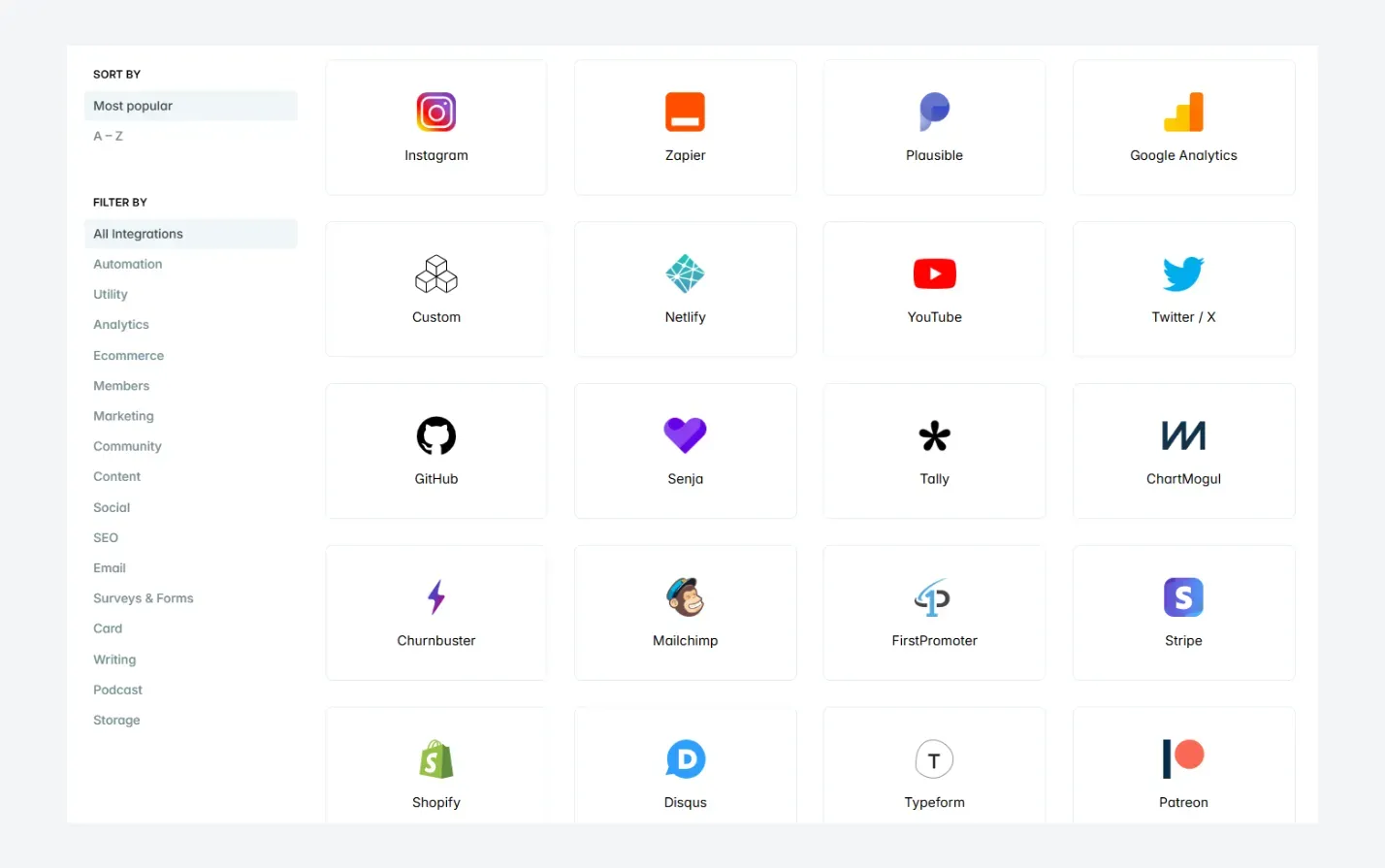
However, those who are in the Ghost community often love it. Developers appreciate the modern codebase and the fact that Ghost is “lean” with fewer moving parts. The smaller community can also mean more direct access to the core team (Ghost is an open-source project run by a non-profit foundation, and they are quite transparent). Still, from a market share perspective, a smaller ecosystem means Ghost doesn’t benefit from the same word-of-mouth and third-party innovation that WordPress does. Fewer plugins and extensions also mean some people will choose other platforms if Ghost can’t do something out-of-the-box that they need.
Competition from Hosted Platforms (Substack, Medium, etc.)
Remember Ghost’s niche – independent publishing and newsletters? Well, there are hosted platforms dominating that space which eat up a lot of potential Ghost users. Substack is a big one: it lets writers launch email newsletters with paid subscriptions easily, and it has a built-in network of readers. Medium offers anyone a place to write blogs and potentially get distribution to Medium’s large audience (over 100 million monthly readers). Beehiiv is a newer contender focusing on newsletter growth tools. Patreon enables creators to get subscription revenue from fans without hosting their own site.
For a creator whose primary goal is to write and get paid, these turnkey platforms can be very appealing. They require zero technical skill – just sign up and start publishing. They also often provide discovery (e.g. Substack has a reading app and cross-promotion, Medium has recommendation algorithms) which can help writers build an audience, whereas with Ghost you are running an independent site that won’t inherently send you traffic. Although Ghost has recently introduced Recommendations feature.
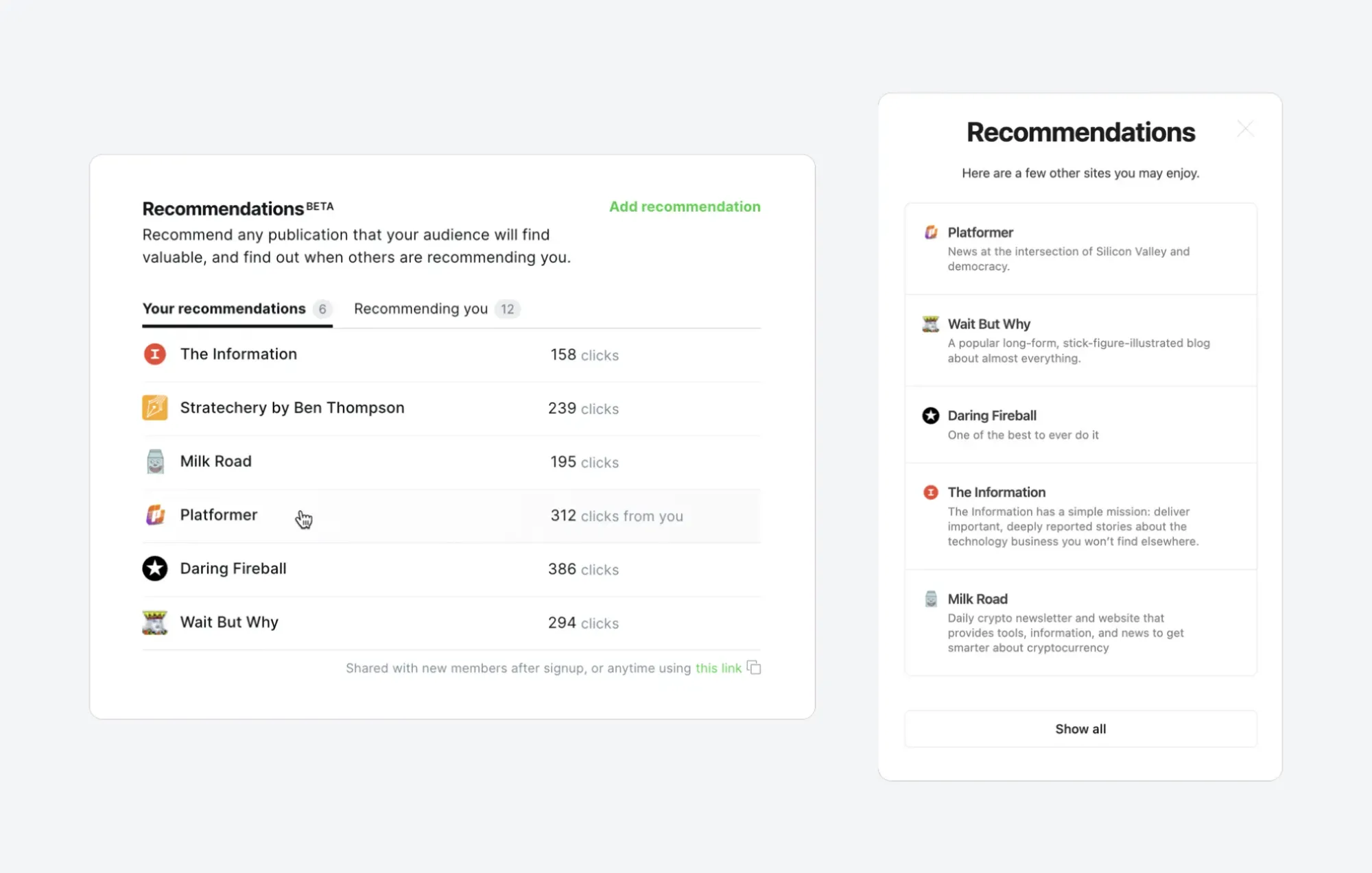
Ghost is essentially offering an alternative to those platforms: more power and ownership in exchange for more responsibility. Ghost has some clear advantages over them – for instance, Ghost doesn’t take a cut of your revenue, unlike Substack’s 10% fee or Patreon’s 5–12% fees. With Ghost you fully own your content, website, and mailing list, which is huge for independence. But many creators might opt for the easy road first, and only later consider Ghost if they outgrow those platforms.
It’s telling that Ghost’s own marketing pages position it as “the independent alternative” to Substack, Patreon, etc., highlighting the 0% transaction fees and greater control. Ghost is basically saying: if you want to build a serious long-term publication brand, you’re better off with Ghost – but you won’t have the instant audience those platforms provide. It’s a challenging sell in a world where convenience often wins. Thus, many potential Ghost users are siphoned off by Substack, Medium, Beehiiv and others, contributing to Ghost’s low overall market share.
Limited Marketing and Mindshare
This point is a bit more speculative, but as someone in the tech scene I’ve observed that Ghost doesn’t market itself aggressively to end users. It’s a non-profit with a small team (Ghost Foundation has ~35 staff as of 2025) and limited budget, so you won’t see Ghost ads all over the internet. Contrast that with Wix, Squarespace, and Shopify – those companies run Super Bowl commercials, YouTube ads, influencer sponsorships, etc. WordPress benefits from millions of users evangelizing it and big companies like Automattic pushing it. Ghost’s growth has been more organic and word-of-mouth among developers and writers.
Because of this, Ghost has a bit of an “underground” quality – many average site owners still haven’t heard of it. Those who have might have misconceptions (some still think of Ghost as that “Kickstarter project” from 2013, not realizing how much it has matured). Ghost’s relative lack of mainstream visibility means fewer people even consider it when choosing a platform, further keeping its market share low.

Story of Ghost CMS - how it all started from a Kickstarter project.
In summary, Ghost’s low market share is not due to a single flaw, but rather a combination of strategic trade-offs and external factors. Ghost focuses on a narrower use-case, requires more technical effort to adopt, and faces fierce competition from both the all-purpose CMS giants and the specialized publishing platforms. The result: Ghost remains a niche player.
Yet, within that niche, Ghost is steadily growing and evolving. Let’s look at how Ghost has been improving and why its users (like me) are excited about its direction, even if it’s not “taking over the world” just yet.
Ghost vs Other Platforms: Features & Usability Comparison
It’s helpful to compare Ghost head-to-head with some of the leading platforms to understand its unique value and limitations. Having used many of these, I’ll give a quick rundown:
Ghost vs WordPress
WordPress is the feature-rich behemoth, while Ghost is the lean, performance-focused upstart. If you need a plugin for every possible thing (SEO tweaks, ecommerce, forms, etc.), WordPress has them. But that flexibility comes with complexity: a typical WP site may have dozens of plugins and a heavy theme, which can slow it down and require constant maintenance.
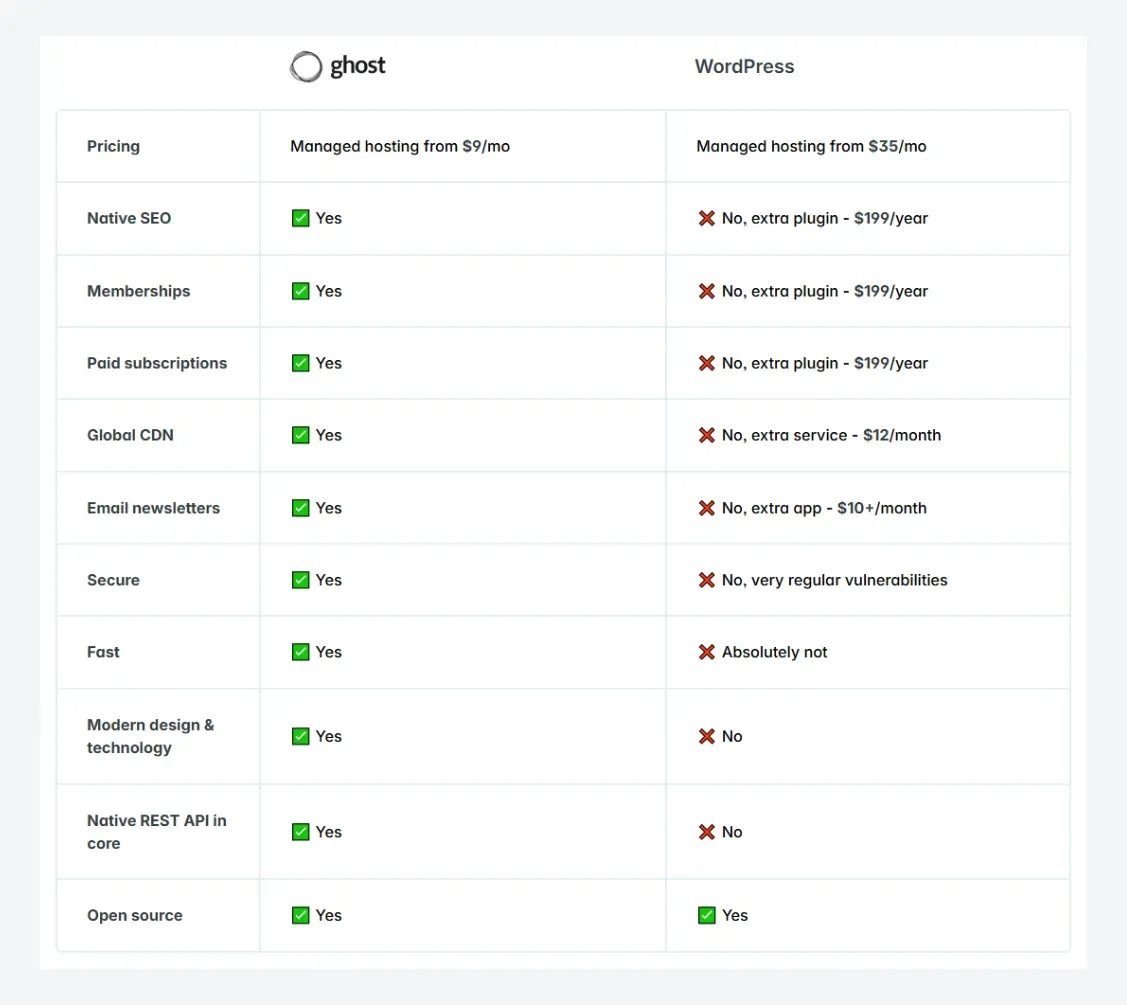
Ghost intentionally avoids this bloat – its core has what most publishers need (a great editor, SEO basics, newsletters, membership, basic analytics) and not much more. In my experience, Ghost feels faster and more streamlined than WordPress. It’s built in modern JavaScript, and it shows – pages load fast, and the admin interface is snappy. WordPress’s UI, even with Gutenberg, can feel clunkier and more old-school in comparison.
Ghost is also simpler to maintain (fewer updates and compatibility issues, since the ecosystem is smaller). On the flip side, WordPress is easier to extend. If Ghost’s limited number of official integrations doesn’t cover something, you might have to get your hands dirty with code or wait for Ghost to add a feature. With WP, you’d likely find a plugin or third-party service readily available.
Usability-wise, WordPress is familiar to tens of millions and can be used by non-technical folks (especially on managed hosts or WordPress.com). Ghost’s admin is very user-friendly for writing, but the deployment aspect is trickier as discussed.
If someone wants a “Swiss Army knife” website builder or an all-purpose CMS, WordPress is the safer bet. If someone wants a focused publishing tool with great performance and built-in membership capabilities, Ghost is a delight. No wonder one fan called Ghost a “modern, fast alternative to WordPress” for those sick of maintaining dozens of plugins.

Ghost vs Shopify
These two serve entirely different purposes. Shopify is for creating online stores – managing products, inventory, payments for physical/digital goods. Ghost is for publishing content and maybe selling subscriptions to that content. There’s almost no overlap. If you need to sell merchandise or run an e-commerce catalog, Ghost is not the tool (though you could embed a simple buy button or link to an external shop).
Conversely, if your goal is to run a magazine or newsletter, Shopify won’t help (aside from maybe its blog feature, but that’s not its strength). The key comparison here is that Shopify’s huge market share (second only to WP) highlights how big the e-commerce CMS market is, which Ghost intentionally isn’t targeting. Many businesses whose primary web presence is a store will choose Shopify or WooCommerce (WordPress).
Ghost ceding this market is one reason its market share stays low. However, Ghost can integrate with e-commerce by embedding products (for example, dropping a Stripe checkout or using something like LemonSqueezy links). It’s just not a native feature. Theme My Blog is an example of running an e-commerce marketplace with Ghost. All themes on this website are managed by 3rd party payment solutions like Gumroad and LemonSqueezy.
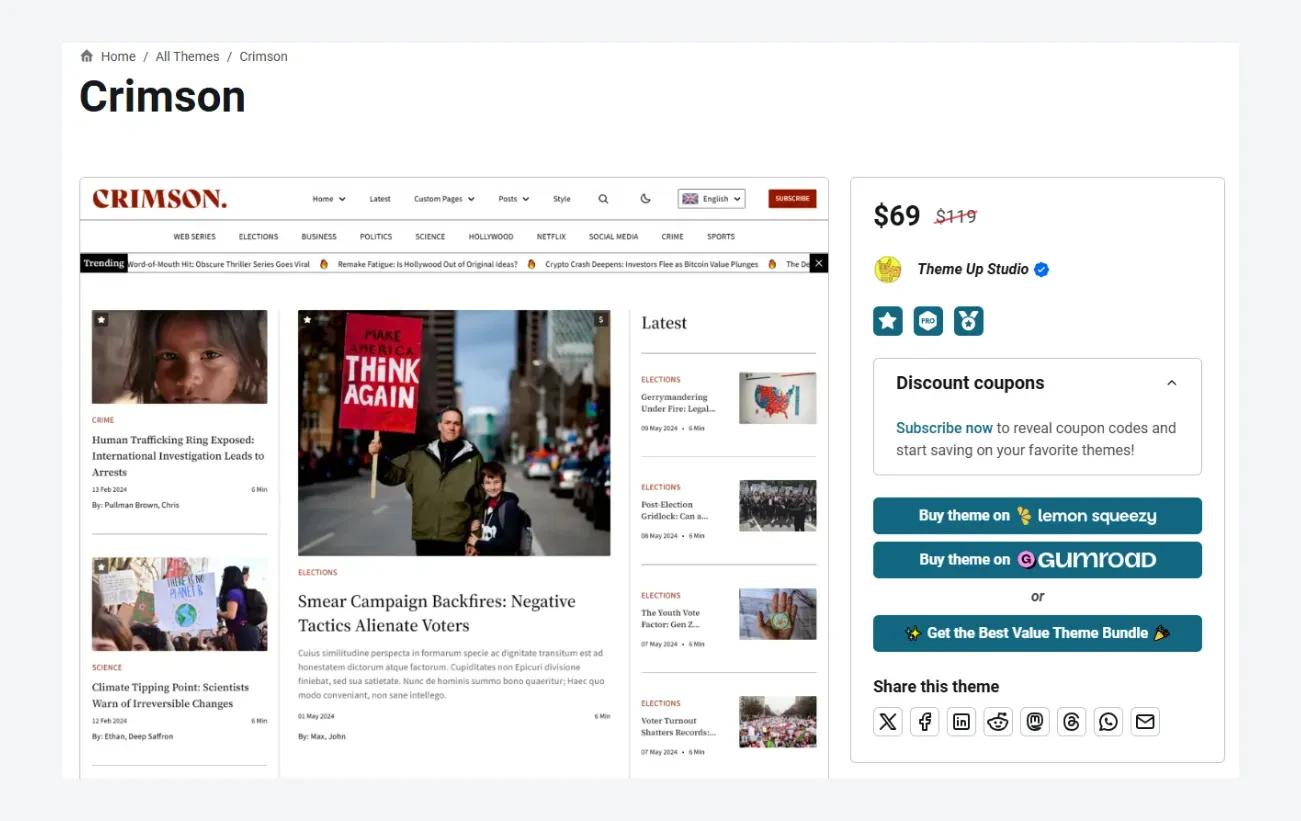
Ghost vs Webflow (and Wix/Squarespace)
Webflow, Wix, and Squarespace are website builders that emphasize design flexibility and ease of use. Webflow in particular is popular among designers because it allows pixel-perfect control in a visual editor, and it can output clean code. These platforms usually have drag-and-drop site building, templates, and host everything for you.
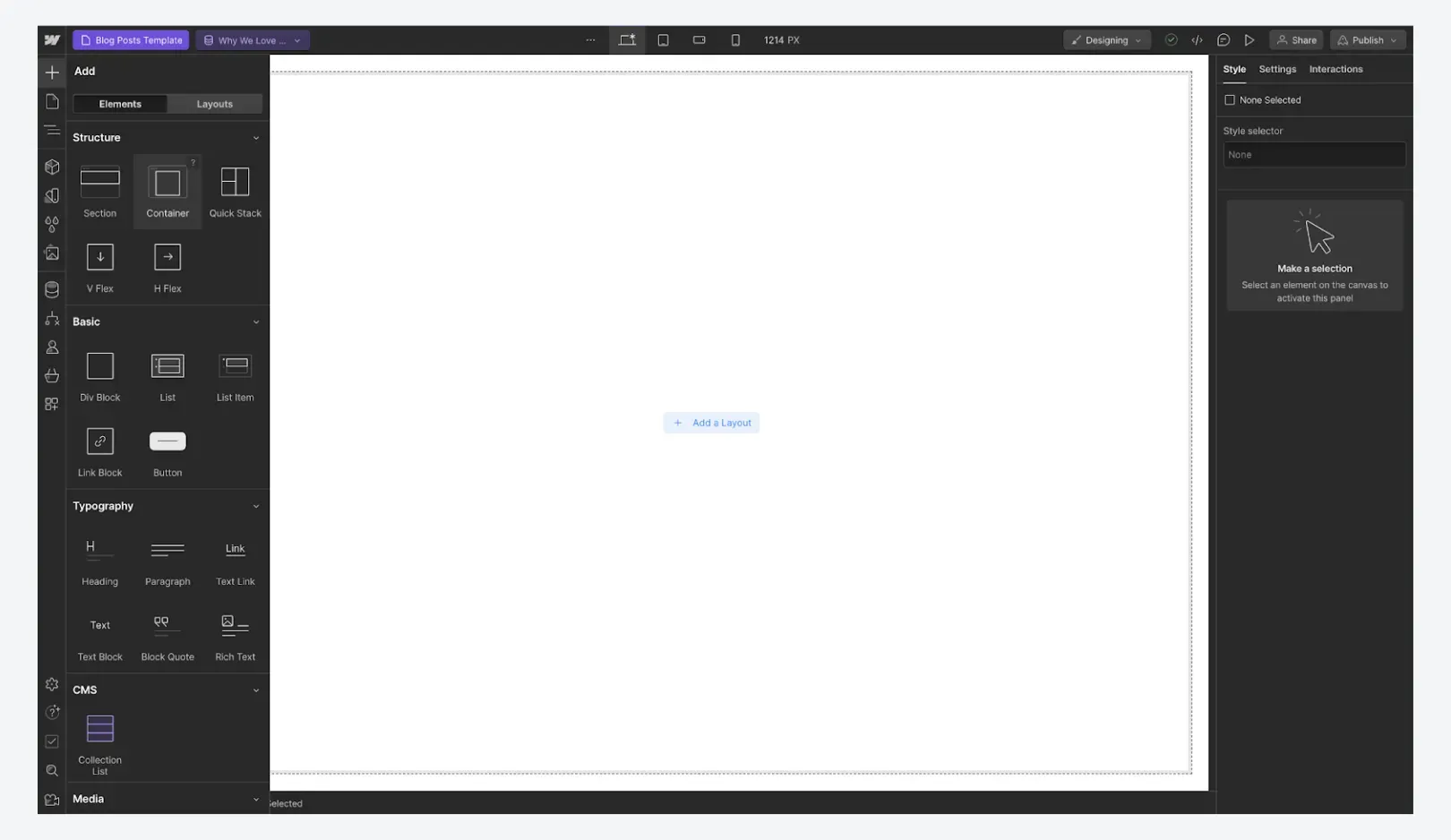
Ghost, in contrast, does not have a drag-and-drop page builder. You typically work with Ghost themes (which require code knowledge to customize deeply) or use the built-in editor for writing posts/pages in a more linear fashion. If a user’s priority is to design a fancy marketing website with animations, custom layouts, etc., a builder like Webflow or Squarespace is more suitable. Ghost is more about the content itself (articles/posts) and a clean blog-style or newsletter-style presentation.
In terms of scalability, both Ghost and Webflow can handle pretty high traffic (Ghost especially has proven scaling – some Ghost sites have millions of views). But audience targeting differs – Webflow/Wix target small businesses, portfolio sites, and anyone who wants a pretty website easily. Ghost targets content creators who value owning their platform and 100% of their content.
Webflow’s market share (~1.1% CMS) is actually higher than Ghost’s, showing that the “no-code design” appeal is strong. Ghost likely won’t ever attract the crowd that just wants to visually build a site without coding – that’s not its goal.
Ghost vs Blogger
Blogger is a free, ultra-simple blogging platform from Google. It had its heyday in the 2000s and still survives (with that 0.5% usage). Blogger is essentially the opposite of Ghost’s modern sophistication – it’s very limited in features (no membership system, very basic templates, etc.), but it’s extremely easy to use and free hosting. Many casual personal bloggers stick with it because it works and they don’t need more. But it’s not attractive for professional use in 2025; it feels outdated.
Ghost offers a massive upgrade in capability and modern design over Blogger, but to move from Blogger to Ghost means going from a free Google service to running your own site (or paying Ghost). Only serious bloggers/writers will make that jump. So Blogger retains a chunk of users that Ghost might have otherwise appealed to if those users ever wanted to “step up” to a more powerful platform. I’d argue Ghost is aimed at a more professional tier of user than Blogger’s typical user.
Ghost vs Medium
Medium is a very interesting comparison. Medium is not a traditional CMS you install – it’s a centralized content platform where all articles live on Medium’s site (with the option of using your own domain). Medium focuses on distribution and community: when you publish there, your content can be surfaced to Medium’s large audience, and readers can follow/clap/comment within that ecosystem. Medium also introduced a membership program where readers pay a flat fee to access premium stories, with payouts to writers based on engagement.
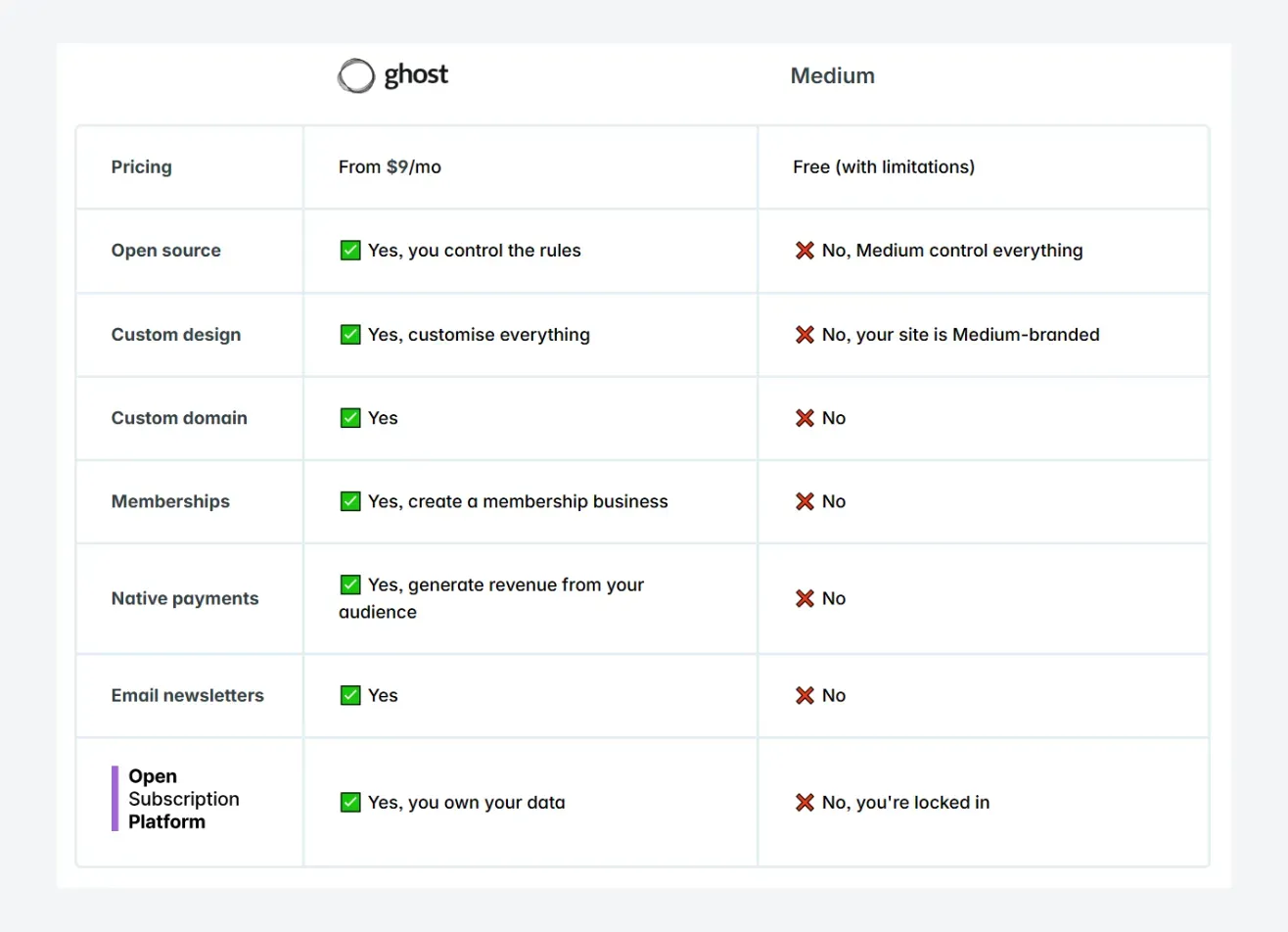
Ghost and Medium both appeal to bloggers/writers, but their philosophies differ. With Medium, you get convenience and network effects but you sacrifice control – Medium could change its algorithms or rules anytime (and it has, many times). You also can’t easily add your own paywall or custom features; you’re in Medium’s sandbox. Ghost is all about owning your platform – your own branding, your rules, your relationship with readers (you get their email addresses, etc.).

Minimalist Philosophy behind Ghost CMS
I have friends who started on Medium to build an audience, then migrated to Ghost for more control and monetization on their own terms. That seems to be a pattern: Medium is great for getting started or maximizing reach quickly, while Ghost is great for owning your publication long-term. Medium’s huge user base doesn’t directly show up as a “CMS market share” anywhere (since it’s one site), but it does indicate a lot of writers chose Medium over starting their own blog – which again means fewer Ghost sites in existence.
Ghost vs Substack (and Beehiiv)
These two are Ghost’s closest competitors in the newsletter + membership space. Substack’s explosive growth since 2017 showed there’s big demand for simple newsletter monetization. Substack reportedly has 20+ million monthly active readers and over 2 million paid subscriptions – a mind-boggling number for a relatively new platform.
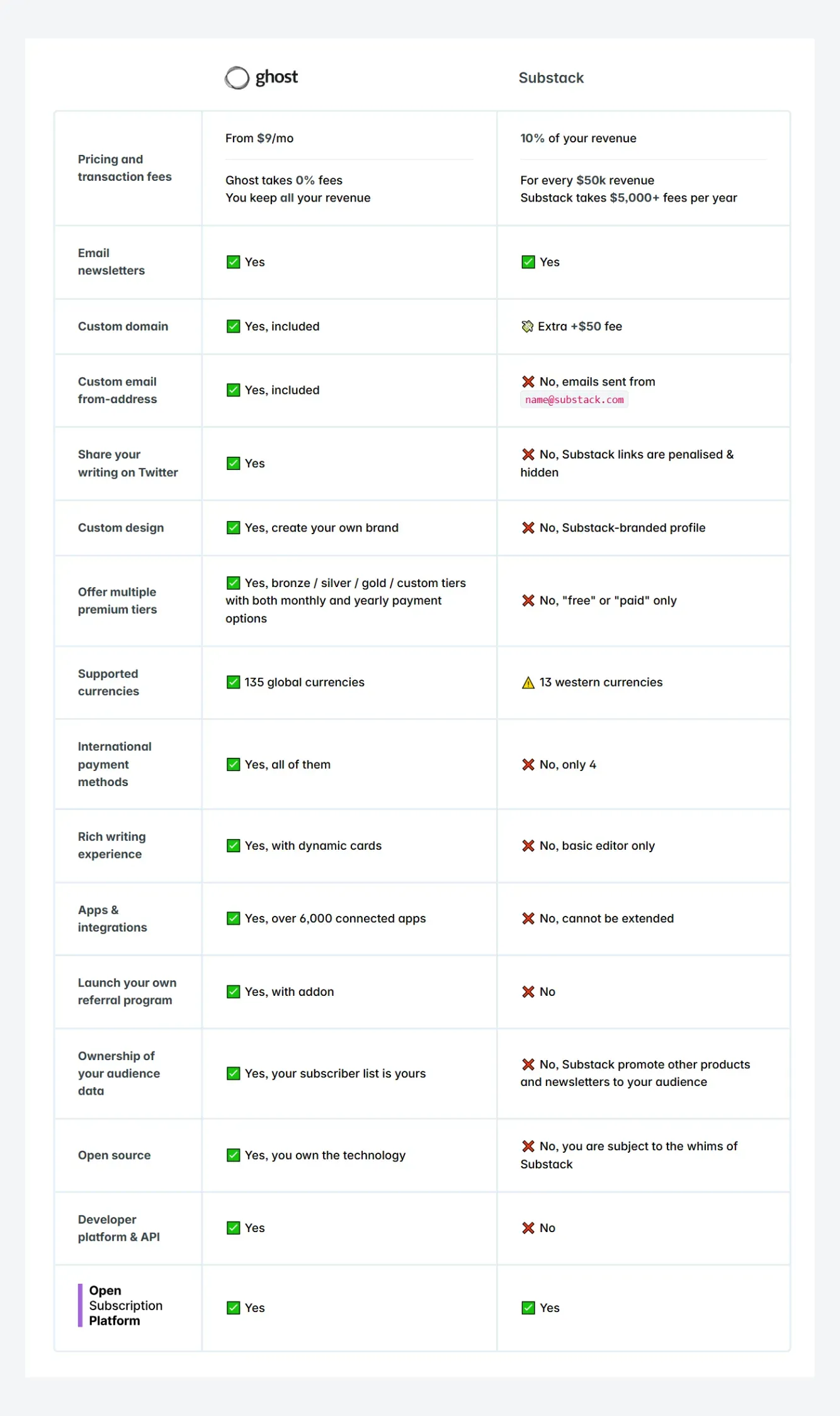
Beehiiv is a newer startup (founded by ex-Morning Brew folks) that offers similar newsletter tools, with a big emphasis on growth features like referral programs and detailed analytics.
Ghost actually introduced its newsletter and membership features around the same time (Ghost 3.0 came out in 2019 with memberships, before Substack became a buzzword). So feature-wise, Ghost can do a lot of what Substack/Beehiiv do: you can have free and paid subscribers, send posts via email, even create referral programs for growth (Ghost added member referral tracking in a recent update).
The key differences: In practice, some content creators use Ghost as a more advanced alternative once they outgrow Substack – but many others are perfectly happy on Substack. So, Substack’s rise likely kept Ghost’s growth more modest than it might have been if Substack didn’t exist.
- Ownership & Fees: Ghost is self-hosted or on Ghost(Pro) (your brand, your domain), and takes no cut of revenue. Substack/Beehiiv host your newsletter on their domain (though custom domains are possible) and Substack takes 10% of subscriber payments (Beehiiv has paid plans instead of a cut). If you’re business-minded, Ghost lets you “keep what you earn” aside from payment processor fees.
- Ease & Network: Substack/Beehiiv require no setup beyond writing; they also have built-in network effects (Substack readers can discover other newsletters, etc.). Ghost requires you to build your own audience from scratch – you have to be your own marketing department. For a writer who isn’t interested in the tech side, Substack is very appealing. Ghost might appeal more to a publication or a creator with an existing following who wants a custom site.
- Features: Substack and Beehiiv have been rapidly rolling out features tailored to newsletter growth (recommendations, analytics, community features). Ghost’s development is a bit slower and more deliberate – they have a roadmap that includes things like better analytics and even integrating with the fediverse (ActivityPub) for reach, but it’s a smaller team building it.
Ghost vs Patreon
Patreon is a platform for creators to get paid by fans via memberships, but it’s not focused on publishing long-form content (creators usually post updates, videos, or give perks on Patreon). Ghost overlaps with Patreon in that Ghost can power a membership site where people pay for premium posts/content. Ghost essentially lets you be your own Patreon, on your own website. This appeals to creators who want to avoid Patreon’s fees and have more control over content distribution. Patreon boasts 8+ million active patrons and about 279,000+ creators as of 2024 - those are creators who might have considered running their own membership site but chose Patreon for simplicity. Ghost likely captures a small subset of that market – typically those who are a bit more entrepreneurial or tech-savvy and want independence.
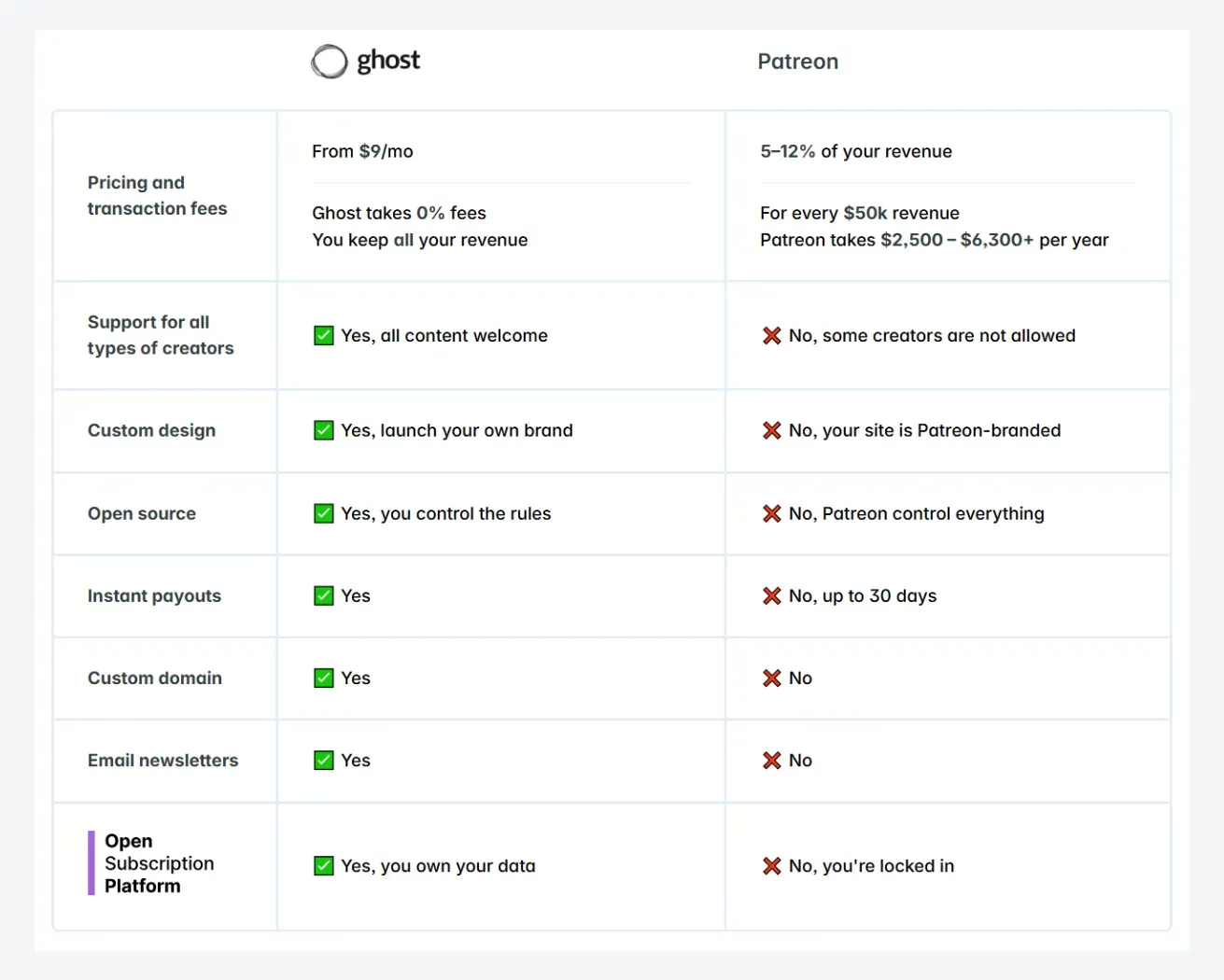
I’ve seen examples of people moving from Patreon to Ghost (for example, a podcast that hosts bonus episodes for members on a Ghost site instead of Patreon). Still, Patreon’s huge user base underscores that ease of use and built-in audience (Patreon has a community aspect) often win over running a custom site. Ghost’s share suffers as a result, even though for a certain segment (like small publishers, news sites, etc.) Ghost is clearly a more powerful solution.
Whew – that’s a lot of comparisons! The takeaway is that each platform has its strengths, and Ghost has carved out a particular niche within a crowded landscape. Ghost is not trying to beat WordPress at being a universal CMS, nor trying to beat Shopify at e-commerce, nor directly beat Substack at being a free-for-all newsletter network. Ghost is charting its own path as a professional-grade, open-source publishing platform that sits somewhat between traditional CMS and newsletter platforms.
From a usability perspective, people often say “use the right tool for the job.” If someone’s job is content + membership, Ghost is an excellent tool – but for many other jobs, other tools make more sense. That context helps explain the market share picture.
Now, despite being a small player, Ghost is actively growing and evolving. It’s worth looking at how Ghost has improved over time and why its current users remain enthusiastic.
Ghost’s Growth and Evolution: More Than Meets the Eye
One might think, seeing only 0.1% market share, that Ghost is stagnating or on life support. Nothing could be further from the truth. Ghost may be small, but it’s quite healthy and growing in absolute terms year over year. The company behind Ghost (Ghost Foundation) is a non-profit that is remarkably transparent about its finances and user base. They publish an annual report and even a live dashboard of stats on their website. As of late 2024, Ghost had 24,000+ active paying customers on Ghost(Pro) – up from 22k earlier in the year. That’s just paying customers; additionally, thousands use the open-source Ghost self-hosted (exact numbers are hard to track, but the open source project has over 48k GitHub stars and 100M+ total installs to date). The revenue Ghost earns is reinvested into development, creating a sustainable cycle (they’re doing over $600k monthly run rate in revenue, which funds the dev team).
Ghost’s product itself has come a long way since its initial release in 2013. Originally, Ghost was a simple blogging platform (basically an alternative to WordPress just for blogging). Over the years, they kept the core clean but added significant features around the core idea of publishing. Some major milestones in Ghost’s evolution:
- Ghost 3.0 (2019): Introduced membership and subscription features, allowing sites to have member accounts, newsletters, and paywalled content. This was a game-changer, aligning Ghost with the rise of paid newsletters. Suddenly you could use Ghost not just for blogging but for running a full membership publication like a Substack, but under your own brand.
- Ghost 4.0 (2021): Brought a new admin design, enhanced editor, built-in tiers for memberships, more integrations, and a native comments feature (previously one had to use Disqus or similar). Performance improved further, and deploying Ghost became a bit easier with official Docker images, etc.
- Ghost 5.0 (2022): Focused on modernization – dropping old Node support, improving the visual editor (Koenig editor) with new cards (for embeds, galleries, etc.), adding native search (finally, Ghost got built-in search functionality for posts, which was something users often had to add via third-party before). Also, Ghost introduced a nice newsletter portal UI so visitors can subscribe easily, and theme improvements for membership sites.
As of early 2025, most Ghost users are on version 5.x (and Ghost 6.0 is likely on the horizon or in development). The platform keeps getting iterative improvements – for example, Ghost has been working on official support for ActivityPub (the protocol behind Mastodon and other federated platforms). This could enable Ghost publishers to directly share content to the fediverse, tapping into a growing decentralized social network. That kind of forward-looking feature shows Ghost isn’t just resting on what it has; it’s adapting to how digital publishing is changing.
Another area of growth: themes and integrations. Ghost now has a marketplace with lots of beautiful themes, many geared toward newsletters, magazines, and personal blogs. While not as vast as WordPress’s theme universe, you can find plenty of modern, responsive Ghost themes to give your site a unique look. On integrations, Ghost provides built-in or documented ways to connect with services like Slack, Stripe, Shopify (for commerce links), Google Analytics, etc. And because Ghost is open source, if you have the coding chops, you can build custom integrations or use its REST and Admin API to hook into other systems. I’ve personally found Ghost’s codebase and docs easy to work with as a developer.
Ghost’s performance and SEO are also strong points of its evolution. Right out of the box, Ghost is quite fast – it’s designed with performance in mind (server-side rendering, good caching, etc.). Many Ghost users highlight that they don’t need to install a dozen performance plugins as they would on WordPress; it’s fast by default. For SEO, Ghost has built-in semantic markup, sitemaps, and schema, so you’re well-covered without extra tools. These factors have helped Ghost attract users who care about site speed and Google rankings but don’t want to tinker endlessly – often a selling point in developer communities.
It’s worth noting that Ghost has attracted “signature clients” and professional publications over time, which adds credibility. The Ghost website proudly lists companies like Apple, Sky News, Buffer, OpenAI, and others as users. Many startups and indie publishers have chosen Ghost to power their blogs or media sites because of the balance it strikes between simplicity and control. This kind of adoption, while not creating WordPress-level numbers, does mean Ghost is proving itself in production for serious use cases. It’s not a hobby project – it’s a production-grade CMS.
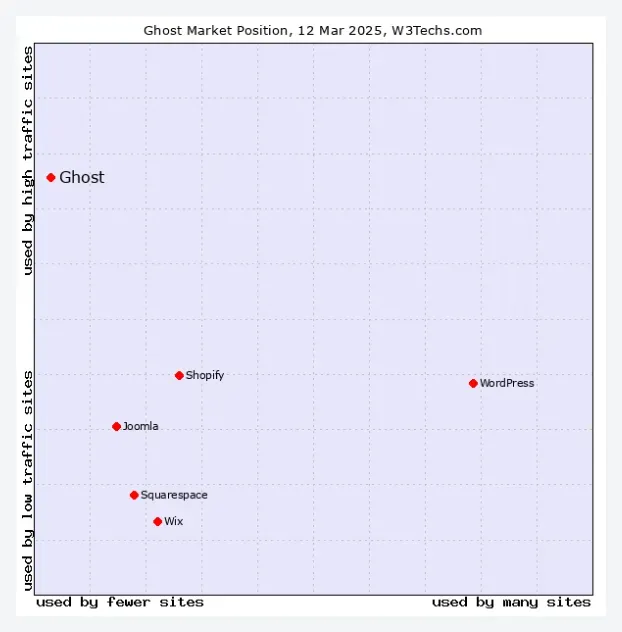
The community, though smaller, is passionate. There’s an official Ghost forum (where I found many insightful discussions) and a Discord server where users and developers chat. The vibe I get is that Ghost users really care about publishing and open source. They often help each other with tips, share theme tweaks, or even contribute to Ghost’s code. Over time, the community has produced many tutorials, custom themes, and even plugins (called “Ghost integrations” or GitHub gists). It’s a friendly but smaller community, which is growing gradually. One active member described it nicely: Ghost’s community “can feel scrappy (open source typically does), but that also means everyone can contribute”.
Financially and operationally, Ghost’s model seems sustainable. The non-profit makes money from Ghost(Pro) hosting, and that funds development. They’ve avoided venture capital, which means no pressure to chase hyper growth or compromise on the open-source mission. In fact, Ghost’s transparency reports show consistent revenue growth and very low churn (meaning people who use Ghost(Pro) stick with it). This indicates Ghost is likely here to stay, even if it’s not “winning” in market share. Ghost is playing the long game, prioritizing a solid product and community over world domination.
All these signs – expanding features, increasing user base, happy customers, cool new integrations – show that Ghost is growing beneath the surface. It may only ever appeal to a specific segment of users, but for those users Ghost is getting better every year. Next, let’s speculate a bit on what the future might hold for Ghost, and whether its market share could improve.
Future Outlook: Can Ghost Grow Bigger (and Does It Need To)?
Looking ahead, I see both challenges and opportunities for Ghost CMS. Will Ghost always be a tiny player, or could it break into a larger market share? Here are some thoughts:
Sticking to Its Niche (Depth over Breadth)
Ghost’s team will likely continue focusing on what they do best – content, membership, and publishing tools – rather than trying to copy WordPress or Shopify. And that’s probably wise. There’s a certain strength in being the best in a niche, even if that niche is small. Ghost has become one of the top choices for independent publishers who want a polished, ad-free, reader-supported site. As more journalists, writers, and educators look to go independent (a trend that seems to be continuing), Ghost stands to gain users. Not everyone will want to jump on Substack’s bandwagon, especially as some writers realize the importance of owning their platform (this is a conversation I see often – people with large Substack followings eventually consider migrating to Ghost or WordPress for the long term). Ghost’s bet is that “creators wanting independence” is a growing segment.
Lowering the Entry Barrier
One thing that could significantly boost Ghost adoption is making it easier for newbies. The existence of one-click installs on some hosts and services like Bitnami, Plesk extensions, etc., helps. If Ghost can partner with more hosting providers for easy deployment or even offer a lighter free tier on Ghost(Pro) to let people test the waters, it might hook more casual users. Ghost’s leadership knows this is a hurdle. I suspect over time we’ll see smoother installation flows or maybe container-based deployment that abstracts the tech away. (Already, running Ghost in Docker is an option many use, which simplifies setup a bit if you’re familiar with Docker.)
Embracing Integrations without Bloat
Ghost has walked a fine line by being “integrations-friendly” but not turning into a bloated platform. I think the future will bring more official integration guides/plugins that extend Ghost’s capabilities without cluttering core. For instance, easier ways to add third-party comments, search (for those who want advanced search), e-commerce links, and advertising could make Ghost viable for a few more use cases. While Ghost likely won’t ever bundle ad networks or shopping carts itself (it would contradict their minimalist ethos), it can document how to connect such services. If they manage this, some bloggers who rely on ads or sell a few products might not dismiss Ghost so quickly. In fact, Ghost already allows inserting code and widgets easily (for example, adding a simple ad script is doable via code injection). It’s more a matter of showcasing these possibilities to potential users.
Competing with Substack/Beehiiv on Growth Features
To retain creators, Ghost will want to offer comparable audience growth and engagement tools. The upcoming ActivityPub integration could be a killer feature – imagine your Ghost blog posts automatically appearing on Mastodon or other fediverse platforms, increasing reach without relying on Google or Facebook. That’s a very modern approach that aligns with Ghost’s independent spirit. Similarly, Ghost might enhance its newsletter analytics, add more community features (maybe lightweight comments or reactions for members), and improve referral/recommendation systems. These are areas Substack and others invest heavily in. Ghost doesn’t necessarily need every bell and whistle, but it should cover the basics so that creators don’t feel they are missing out by not being on Substack/Beehiiv. The roadmap hints at exactly these kinds of improvements.
Growing the Community and Ecosystem
Ghost’s ecosystem will naturally expand as its user base grows. In the future, we may see more third-party developers creating Ghost add-ons, more theme developers selling Ghost themes, and maybe even agencies specializing in Ghost site development. This is already slowly happening. The easier it becomes to work with Ghost, the more people will build on it. If the community can produce, say, an equivalent of a “Ghost plugin marketplace” (even if unofficial), it could attract users who need that one extra feature. Ghost’s team could also invest in more community engagement – perhaps grants or bounties for developing open-source Ghost plugins, etc. An expanded ecosystem can have a snowball effect on adoption.
Market Share: Remain Humble or Rise?
Realistically, I don’t foresee Ghost leaping to a large market share percentage in the next few years. The gap to WordPress or even Shopify is enormous, and Ghost isn’t aiming to replace those. However, I could see Ghost doubling its share from 0.1% to 0.2% or 0.5% over time as more content creators turn to it. That would still be small in percentage terms, but it would represent a significant growth in absolute number of sites (from ~10-20k sites to perhaps 50k+ sites). If Ghost ever hit 1% of the CMS market, that would be a huge win and likely place it in the top 10 CMSs.
But importantly, the Ghost founders don’t seem obsessed with the percentage share. They care about making Ghost sustainable and impactful for those who use it. In their view, “‘Small market share’ isn’t the best measure; the company’s actual metrics and the community’s passion tell a different story.”. This sentiment was echoed by a Ghost user who pointed out that Ghost’s transparency and steady revenue mean it’s not going anywhere, regardless of its Alexa rank or W3Techs stats. So the future outlook might be: Ghost continues steadily growing its user base and revenue, even if its market share percentage stays “low” compared to giants. And that’s okay.
In conclusion, Ghost CMS has a low market share because it’s tailored for a specific audience and it refuses to sacrifice its vision for mass adoption. Factors like a higher technical bar, a smaller ecosystem, and tough competition in adjacent spaces have kept Ghost’s numbers modest. However, Ghost is thriving in its own right – it’s evolving with new features, attracting dedicated users, and proving that bigger isn’t always better when it comes to community and quality.
I don’t choose Ghost because it’s the most popular; I choose it because it fits my needs as a writer who values performance, ownership, and simplicity. And I suspect many others will continue to discover that value proposition.
Ghost may never rival WordPress’s empire, but it doesn’t need to. It has already succeeded in creating a sustainable platform that empowers creators – and as the web continues to move toward independent publishing and niche communities, Ghost’s star could shine a bit brighter each year. Market share be damned – what matters is that Ghost is here to stay and keeps getting better for those of us who love using it.

